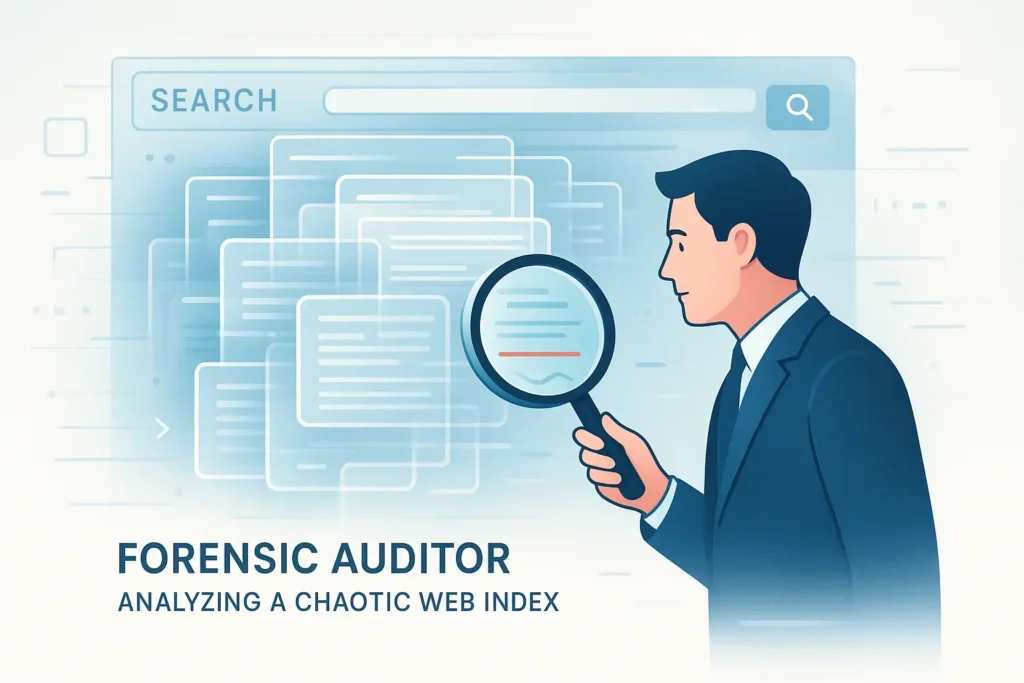Search engines are not infinite storage bins. They thrive on efficiency, clarity, and trust. Yet, as AI-generated content has exploded and automation-driven publishing has gained traction, an unexpected villain has emerged—index bloat. It’s the quiet suffocation of crawl budgets and search visibility, born from endless near-duplicate, low-value, or mass-produced pages. This article breaks down how forensic auditing can help uncover, analyze, and mitigate the index bloat problem—especially in cases where AI-driven publishing or templated duplication spins out of control.
Understanding Index Bloat in 2025
Index bloat refers to the presence of excessive or low-value pages in a search engine’s index. Not all indexed pages add value. Many of them:
- Cannibalize keywords
- Confuse crawling patterns
- Push down important assets in search
- Trigger search engines to distrust a domain
The explosion of AI writing tools and automated publishing pipelines has only added fuel to the fire. Hundreds, sometimes thousands, of “slightly different” pages start appearing. For a while, they may even rank. But long-term? They erode domain authority and lead to crawling inefficiencies.
Where AI and Near-Duplicate Pages Enter the Picture
AI content is not inherently bad. The issue arises when:
- Templates are used without meaningful variation.
- Thousands of programmatically created pages target trivial keyword permutations.
- Content spinning creates syntactic differences but semantic sameness.
Examples:
- “Best hotels in New York for couples” vs. “Top hotels in New York for couples in 2025” vs. “Hotels in New York best for couples” — all technically different, but not value-unique.
- AI-generated product descriptions for thousands of SKUs, each with only 2–3 words shuffled.
This leads to diluted topical relevance. Google and Bing are increasingly good at detecting these patterns. Instead of rewarding quantity, they prune aggressively.
Why a Forensic Audit Is the Right Approach
Unlike a casual site audit, a Forensic auditing dives into root causes. It treats index bloat like a crime scene: identifying what happened, how it spread, and how to contain it.
A proper Forensic auditing:
- Maps the scale of duplication.
- Identifies crawling inefficiencies.
- Pinpoints thin, near-duplicate, and AI-patterned clusters.
- Builds remediation priorities—what to remove, consolidate, or canonicalize.
Step 1: Crawl the Website with Granularity
The starting point is a full crawl. Tools like Screaming Frog, Sitebulb, or custom-built crawlers can expose:
- Near-duplicate titles and meta descriptions
- Thin body content
- Parameter-driven or auto-generated pages
The forensic twist is in segmentation. Instead of one big crawl report, group URLs by:
- Content clusters
- Publication method (manual vs. AI-generated)
- Template type
This reveals which sections are truly infected.
Step 2: Compare Index vs. Sitemap vs. Crawl
Index bloat often hides in the mismatch.
- Sitemap may show 10,000 URLs.
- Crawl may surface 25,000.
- Google Search Console may report 50,000 indexed.
The forensic auditor asks: Where did those extra 25,000 come from?
AI-based publishing platforms often create ghost categories, tag archives, and minor variations. These never make it into the sitemap but silently slip into the index.
Step 3: Duplicate Content Clusters
Next, cluster analysis. Using similarity scoring (shingles, cosine similarity, or NLP embeddings), group pages that overlap beyond a healthy threshold.
Red flags include:
- Pages that are 80–90% identical except for city names or years.
- Auto-generated FAQs that repeat the same structure endlessly.
- AI-written “listicles” where the only difference is swapping a few adjectives.
These clusters are where index bloat thrives.
Step 4: Crawl Budget and Log File Analysis
A Forensic auditing isn’t complete without log files. These reveal how search engine bots spend their time.
Signs of trouble:
- Crawlers repeatedly hitting near-duplicate pages.
- Important money pages being visited infrequently.
- Huge portions of the crawl budget wasted on infinite AI content.
Think of it like financial fraud—money (crawl equity) being funneled away from where it matters.
Step 5: Build the Remediation Plan
Here’s where cleanup begins. Strategies include:
- Canonicalization → Point duplicates to a single authoritative version.
- Pruning → Remove outright low-value or redundant pages.
- Consolidation → Merge several weak AI-generated pages into one strong asset.
- Blocking → Use robots.txt or noindex to prevent indexing of parameterized junk.
- Template re-engineering → Ensure AI/content automation produces unique, substantial value.
The Business Impact of Ignoring Index Bloat
Many site owners underestimate the cost. But index bloat impacts:
- Rankings → Search engines distrust domains with excessive fluff.
- Visibility → Important URLs buried under AI-driven clutter.
- Efficiency → Crawlers waste cycles, delaying discovery of high-value updates.
- Revenue → Less visibility = fewer conversions.
What looks like harmless scaling can eventually become a silent penalty.
Forensic Auditing as an Ongoing Discipline
One-off cleanup isn’t enough. AI-driven publishing is like a faucet—left unchecked, it keeps dripping. Forensic auditing should be baked into ongoing SEO maintenance. Quarterly audits, log reviews, and duplicate detection must become routine.
Just as financial auditors protect companies from hidden leaks, forensic SEO audits protect digital assets from the slow bleed of index bloat.
Final Thoughts
AI has revolutionized content creation. But scale without discipline backfires. Near-duplicates, template overload, and mass AI pages quietly destroy search performance. Forensic auditing offers a structured way to expose and fix the problem.
If your website is struggling with crawl inefficiencies, vanishing rankings, or bloated indexes, it’s time to consider a deep forensic audit. A professional review at SEOsets.com can be the turning point before bloat turns into long-term damage.
FAQs
1. What is index bloat?
Index bloat is when search engines index too many low-value, duplicate, or unnecessary pages, reducing the visibility of important content.
2. How does AI-generated content cause index bloat?
When AI is used at scale without quality control, it creates thousands of near-duplicate pages with little unique value, overwhelming the index.
3. What’s the difference between a regular SEO audit and a forensic audit?
A regular audit checks for best practices. A forensic audit digs deeper, identifying root causes of index inefficiencies, duplication, and crawl waste.
4. How can index bloat hurt SEO performance?
It wastes crawl budget, dilutes relevance, confuses search engines, and reduces trust in the site—leading to weaker rankings.
5. Can index bloat be fully fixed?
Yes, through pruning, canonicalization, consolidation, and structured auditing. But prevention is just as important as cleanup.
6. How often should forensic audits be done?
Quarterly audits are recommended for sites with heavy publishing pipelines or AI-driven content strategies.
7. Are AI pages always harmful?
No, AI content can perform well if it’s original, insightful, and adds real value. Harm arises only when it produces repetitive or near-duplicate assets at scale.


